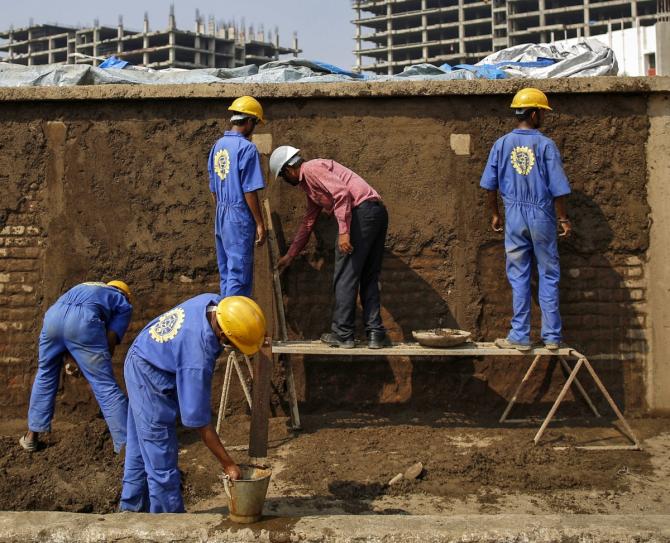Severe skilled, unskilled shortage threatens to pull emergency brakes on India's industrial engine.

For an ambitious India Inc aiming to leap forward, an acute shortage of workers -- both skilled and unskilled -- is threatening to hold it back.
Recently, India's largest engineering and construction firm, Larsen & Toubro (L&T), flagged a shortage of 25,000 to 30,000 labourers.
The 'sit up and take note' comment from Group Chairman S N Subrahmanyan comes at a time when L&T's clients are accelerating project execution, making the gap more noticeable than ever before.
The talent shortage or skills gap has been a persistent issue in the industry.
A marathon general election and extreme heat have only exacerbated the problem.
The shortage of skilled labour appears to have hit India's engineering and capital goods firms the hardest.
Industry executives attribute the shortage to a mix of India's growing order book and increasing demand, while other factors impact the supply end.
An executive who does not wish to be named says: "Not all labour is skilled, and those we skill, we tend to lose to markets like West Asia due to better pay. Preference for an air-conditioned work environment is another factor impacting labour supply for engineering firms."
L&T alone has an outstanding order book exceeding Rs 4.75 trillion, last reported for March.
Mind the gap
The shortage in the skilled workforce is a concern, says Jayant Acharya, joint MD and CEO, JSW Steel, India's top producer of the alloy.
"The propensity for labour to work in their areas has increased after the pandemic. Some moved back to vote during elections, and coupled with the heatwave, many didn't return or delayed their return. But we expect this issue to be resolved with the monsoon setting in," Acharya says.
JSW Steel faced an outflow of migrant workers at Vijayanagara in Karnataka, where it is adding 5 million tonnes (mt) of capacity. The company's capacity in India currently stands at 28.2 mt and will increase to 37 mt in 2024-2025.
Another major steel producer in the middle of expansion says that the workforce shortage was a problem, although it hadn't impacted the project timeline yet.
Steel firms have been on a capital expenditure spree. India's targeted steel capacity for 2030-2031 is 300 mt, and the top players have tuned up their plans accordingly.
The looming question is whether the worker shortage will throw a spanner in execution timelines.
In Tiruppur, the knitwear capital of India, the shortage of migrant employees was around 40 per cent before the elections. It has now decreased to 10 per cent.

Skill chasm
A big part of the shortage, many in the industry point out, can be ascribed to the skill gap.
The problem is widespread, affecting various sectors and levels of hires -- from engineers to daily-wage workers.
According to Chennai-based CIEL HR Services, there is a 10 to 20 per cent workforce shortage in the manufacturing sector, impacting roles like machine operators, welders, fitters, drivers, technicians, carpenters, and plumbers, among others.
"Organisations have been struggling to find suitable talent due to various reasons, including the availability of skilled workers and seasonality factors like festivities, sowing, and harvesting. Alternative employment opportunities in e-commerce, transport, construction, and event management also put pressure on the supply side," says Aditya Narayan Mishra, MD and CEO of CIEL HR.
Krishnendu Chatterjee, vice-president of TeamLease, says that at any point in time, there are 30,000-32,000 open positions for TeamLease -- a large part of which is in frontline sales in banking, financial services and insurance, consumer, retail, and manufacturing. "At best, we can fulfil one-third of the open positions, and that's due to the skill gap."
Chatterjee also says that the southern states, which have become hubs for electronic contract manufacturing, desperately need headcount. "And there is a lack of it."
Higher wages
The impact of the shortage is evident in various ways.
Wages have increased due to the shortage of workers, with Rs 1,000 a day now becoming the new benchmark for daily-wage workers, according to Hari Mohan Bangur, chairman of Shree Cement.
The shortage, Bangur observed, affects both skilled and unskilled workers. "Wherever there is a delay in project execution, it is due to the shortage. But we have taken precautions."
India's infrastructure boom has spurred expansion not only in the steel sector but in cement as well.
Estimates suggest that the Indian cement sector will add at least 150-160 mt per annum capacity in the next five years.
Even cement industry employees not reporting a direct labour hit agree that demand is an indirect casualty.
Deepak Khetrapal, CEO and MD of Orient Cement, says: "The cement sector, by nature of its operations, does not employ much migrant labour. Given the remoteness of its locations, cement units upskill and hire labour locally, so there is no issue of labour wanting to return elsewhere."
"Instead, the industry sees an indirect impact, where labour shortages on our client/customer side lead to a slowdown in construction activity, affecting cement demand," adds Khetrapal.
"This was evident in the current quarter, where our clients faced a labour shortage due to elections, severe heat, and other factors."

Managing shortage
Companies are dealing with the shortage in various ways.
"Normally, contractors manage the manpower. But now that there is a crunch, we are supplementing efforts by sending our teams to attract people from different catchment areas and locations where they are available for our projects," Acharya says.
Skilling and upskilling are other strategies to manage the shortage. Energy companies like JSW Energy are undergoing massive hiring processes.
"A lot of reskilling and upskilling is being done. We are tying up with institutes and training centres -- the focus is on reskilling (engineers) because this will become a problem for the country," Pritesh Vinay, director-finance for JSW Energy, said in an interaction with Business Standard in May.
The attrition rate, Vinay said, was higher in 2022-2023 at 8 per cent but had now tapered to 5 per cent.
Engineering firm Thyssenkrupp Industries India has been in the process of setting up three different welding schools within the past five years.
"We have seen Tata Consultancy Services and Infosys hire all the mechanical, civil, and instrumentation engineers over the past 10-15 years. But after quite some time, the core sector is really doing well. We are working at various levels to keep talent excited," Vivek Bhatia, MD and CEO of Thyssenkrupp Industries India, says.
Retaining workforce
Sourcing is a challenge, but retaining the workforce is equally challenging.
"Companies are offering weekly trips for employees, screening movies in local languages, and providing North Indian cuisines in hostels. They are even helping them continue their education," K M Subramanian, president of the Tiruppur Exporters Association, says.
There are roughly 20,000 units in Tiruppur, employing around 600,000 people. At least 200,000 to 300,000 will likely be migrant workers from North India.
Improved facilities have also been a big focus for JSW Steel.
"Our Vijayanagara plant has a large ecosystem. We have provided various facilities for workers, including better accommodation, transportation facilities, and recreational activities to attract and retain people," Acharya says.
Skill paucity
- Skilled labour shortage has hit India's engineering and capital goods firms the hardest
- In Tiruppur, the knitwear capital of India, shortage of migrant employees was around 40% before elections. It has now decreased to 10%
- There is a 10-20% workforce shortage in the manufacturing sector
- Labour shortage has led to increased wages, with Rs 1,000 a day now becoming the new benchmark
Feature Presentation: Rajesh Alva/Rediff.com












 © 2025
© 2025